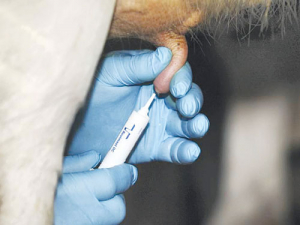Understanding udder health
Last month we talked about why dry cow management is critical, though often overlooked. This month I wanted to dive further into the dry period’s importance to udder health.
 Treatment options for cows at dry-off include dry cow therapy, internal teat sealant or whole herd therapy.
Treatment options for cows at dry-off include dry cow therapy, internal teat sealant or whole herd therapy.
Most of the spring calving cows have now been dried-off and will be enjoying their ‘annual holiday’.
This is an ideal time to pause briefly, reflect on the dry-off and consider whether any adjustment to the calving management strategy might be beneficial.
Given the difficulties of this season, all costs have been closely scrutinised and treatment cost at drying-off has been no exception. As a result, some farms have needed to compromise on costs at dry-off.
The treatment options for cows at dry-off will have included antibiotic dry cow therapy, internal teat sealant (or a combination of both), whole herd therapy, selective therapy and maybe different choices of these options for different cows or groups of cows.
We can consider the impact of a compromise in terms of the two broad goals for dry-off treatment – the treatment of existing infections and the prevention of new infections.
Understanding how any changes to your treatment protocols may have influenced cure rates of existing infections and/or the prevention of new infections will allow you to consider your options at calving.
For example, if you elected not to use an internal teat sealant, the effect will be on the prevention of new infections, because the role of internal teat sealants is to provide an improved physical barrier to infection.
The major role of antibiotic dry cow therapy is obviously the treatment of existing infections, but it can often also enhance the prevention of new infections in cows that have been treated. Hence a change may have an effect not only in curing existing infections, but also to some extent on the prevention of new infections in those animals that were treated.
But this is not the whole story.
The actual dry-off process plays a significant role in the prevention of new infections, because how a cow is dried-off influences the quality of the natural teat plug that forms in each teat canal in the few days after she has been dried-off.
A couple of key questions may indicate if that process was not ideal. Have you seen any cows drip milk after dry-off? Have you had any swollen quarters, clinical cases of mastitis or sick cows after dry-off? If so, it is likely there will be an impact on the risk of mastitis at calving.
For most farms, drying-off is one of the biggest influences on the risk of mastitis at calving and in early lactation, so if you think your dry-off may have increased the risk of mastitis at calving, what can you do?
A well designed calving management plan will certainly help to reduce the risk of mastitis at and shortly after calving.
A discussion with your Dairy Australia Countdown trained vet and advisers is likely to explore the key risk factors outlined in the Countdown Farm Guidelines for Mastitis Control.
1. How can you minimise the exposure of teats to environmental contamination?
2. What is your strategy to deal with cows that drip milk before calving?
3. How do you manage cows, especially heifers, with udder oedema?
4. Do you milk freshly calved cows and heifers as soon as possible after calving (preferably within 12 hours)?
5. How can you minimise the exposure of fresh cows to environmental bacteria after calving?
6. How will you rapidly detect and treat clinical cases of mastitis early enough to reduce the risk of spread?
Commonly these strategies involve little or no expenditure, but may require a change in management.
Take the time to discuss and explore your options with your vet and advisers to see how you can get the best result.
Any supporting information you can bring to a discussion with your adviser, e.g. milk culture results, clinical case records, etc, will improve the value of that discussion.
No matter what option you decide on, prevention of clinical mastitis and new mastitis infections at calving must be a good outcome for the rest of the lactation.
Rod Dyson is a veterinary surgeon and mastitis advisor at www.dairyfocus.com.au
Effective from 1 January 2026, there will be three new grower directors on the board of the Foundation for Arable Research (FAR).
The National Wild Goat Hunting Competition has removed 33,418 wild goats over the past three years.
New Zealand needs a new healthcare model to address rising rates of obesity in rural communities, with the current system leaving many patients unable to access effective treatment or long-term support, warn GPs.
Southland farmers are being urged to put safety first, following a spike in tip offs about risky handling of wind-damaged trees
Third-generation Ashburton dairy farmers TJ and Mark Stewart are no strangers to adapting and evolving.
When American retail giant Cosco came to audit Open Country Dairy’s new butter plant at the Waharoa site and give the green light to supply their American stores, they allowed themselves a week for the exercise.
President Donald Trump’s decision to impose tariffs on imports into the US is doing good things for global trade, according…
Seen a giant cheese roll rolling along Southland’s roads?